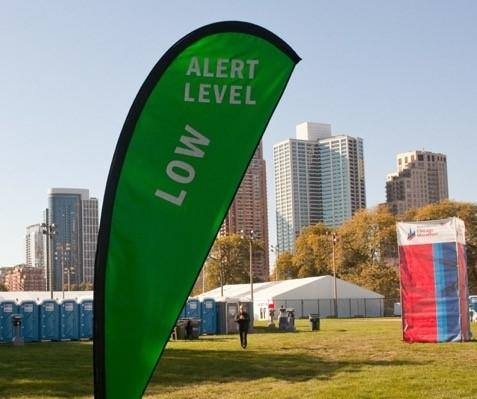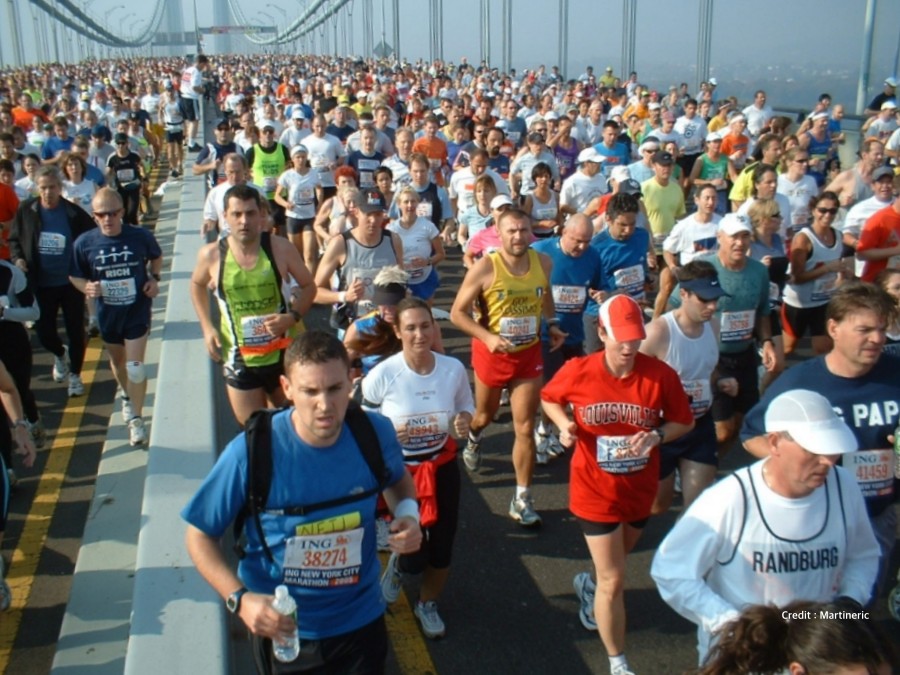Medical support booths were overwhelmed by hundreds of runners suffering from dehydration, dizziness, and high fever. Although 25 medical stations were set up along the marathon course, they proved insufficient. Some booths treated thousands of participants. This took place on November 6, 2022, during the TCS New York City Marathon—one of the “Big Six” major marathons. On that day, the temperature at the finish line in Central Park reached 24 °C—the hottest since the race was moved to November in 1986. Faced with unprecedented early-November heat and high humidity, even seasoned runners were helpless. Around noon, the organizers raised the warning level and advised participants to slow down. In the end, hundreds dropped out mid-race, and of the roughly 50,000 starters, only about 47,000 crossed the finish line.
The scenes from the 2022 New York City Marathon are no longer unusual. In September of the following year, the marathon’s official training series was canceled due to flooding, and in October, the Twin Cities Marathon in Minnesota—a race with a 40-year history—was abruptly canceled because of extreme heat. As an outdoor sport, marathons are highly susceptible to weather conditions, and their long duration increases athletes’ exposure to climate risks. Today, heatwaves, typhoons, floods, strong winds, and wildfires—fueled by climate change—are disrupting marathons and affecting runners around the world.
Marathon season is in full swing. This spring alone (from March to May), a total of 47 marathon events took place across the country. While it may have been an especially exciting season for marathon enthusiasts, the reality is bittersweet—because as soon as the races end, concerns about the very survival of marathons in the face of climate change begin to surface. In that sense, it’s a cruel spring.
Running under the blazing sun may sound romantic — but is it really?
What challenges runners the most during long-distance runs? Sore legs? Labored breathing? For beginners, perhaps — but for seasoned marathoners, the biggest obstacle is undoubtedly hot weather. When the temperature rises, even walking can feel exhausting. A study analyzing 1.8 million race results from runners who participated in the six major marathons — Berlin, London, Paris, Boston, Chicago, and New York — between 2001 and 2010 found that the ideal temperature for marathon running falls between 3.8°C and 9.9°C. More specifically, male runners performed best at 3.8°C ±5°C, while female runners performed best at 9.9°C ±5°C. As temperatures rose above these thresholds, athletic performance declined, and dropout rates increased. In fact, most marathon world records have been set in the early morning hours of spring or fall, when temperatures were a cool 10–15°C. The American College of Sports Medicine (ACSM) recommends canceling marathons when the Wet Bulb Globe Temperature (WBGT), which accounts for humidity and perceived heat, exceeds 27.7°C. Some experts argue that even this threshold is based on elite athletes, and that amateur runners should avoid running if the WBGT surpasses 20.5°C.

The reason marathons are particularly sensitive to temperature is due to the high health risks associated with heat stress. Elevated temperatures significantly increase the risk of heatstroke during running. Mild heat-related illnesses typically manifest as headaches, nausea, and dizziness. However, severe heatstroke occurs when the body fails to regulate its temperature, causing core temperature to rise above 40°C — a medical emergency. If the body is not cooled quickly in this state, it can lead to serious complications, including damage to the brain and major organs.
When the body heats up, it cools itself down by sweating. However, excessive sweating leads to the loss of fluids and electrolytes. According to the Road Runners Club of America (RRCA), runners lose between 170 to 350 ml of fluid every 20 minutes. Without frequent rehydration, runners are at risk of dehydration. Furthermore, if lost electrolytes are not replenished promptly, it can lead to an electrolyte imbalance, which — in the worst cases — may result in cerebral edema (brain swelling).
In the Era of Climate Crisis: Survival Strategies for Marathons
A heating planet poses a significant risk not only to runners but also to race organizers. To ensure the safety of participants, organizers must shoulder higher insurance costs and establish refund systems in case of cancellations. These added expenses inevitably lead to increased registration fees. Climate change is a burden for runners—but it’s also a burden for organizers. When a race becomes a burden for both, its disappearance becomes almost inevitable. This is why the climate crisis is also a crisis for marathons.
To ensure the survival of marathons, the industry is adopting various adaptation strategies. One notable example is the “Safe Event Guideline” issued by the Road Runners Club of America (RRCA), which offers several measures to address extreme heat. First and foremost, if the heat is severe, race organizers are advised to consult with medical teams and consider canceling the event. If cancellation isn’t necessary but high temperatures are expected, one option is to adjust the race start time to early in the morning—around 8 a.m. To prevent dehydration among runners, more hydration stations should be installed along the course. Cooling shelters should also be set up before and after the race to allow runners to escape the heat. Additionally, organizers should consult with medical professionals in advance to prepare sufficient medical personnel, supplies, and ice. At the finish line, medical staff should be stationed as close to the line as possible to provide immediate assistance to runners in need. Racecourse access points should be identified and shared in advance to ensure emergency medical teams can quickly enter the course in the event of an incident. It’s also essential to provide race staff with the exact locations and contact information of medical support stations, enabling them to respond quickly when necessary. Finally, to prevent confusion during an emergency, it’s recommended that a designated media spokesperson be assigned ahead of time to ensure accurate communication with the press.

Providing runners on the course with continuous, real-time weather updates on race day is also crucial. One effective method is implementing a “race alert system.” Originally developed by the U.S. military to monitor heat stress for soldiers, this system has also been adopted by the American College of Sports Medicine (ACSM). The alert system displays the heat stress levels using four color codes: green indicates low risk (WBGT 29.3°C or below), yellow means moderate risk (WBGT 29.4°C to 31°C), red signals high risk (WBGT 31.1°C to 32.1°C), and black represents very high risk (WBGT 32.2°C or above). By installing electronic boards or flags along the course to communicate these alert levels to runners, participants can adjust their pace or hydrate accordingly to safely manage the race.

To Enjoy a Classic Sport in a New Way
The marathon industry’s adaptation efforts may help put out the immediate fire, but considering the worsening climate crisis, they are only temporary measures. Will marathons continue to be as popular as they are now? Research shows that by the end of the 21st century, the number of cities able to host Olympic marathons will decrease by 27%. Global warming is shrinking the regions where marathons can be enjoyed, and the lengthening summers are reducing the time available for running them. This is why there are calls to hold the Olympic marathon in October. Changes to marathons due to the climate crisis are inevitable. It might even evolve into an indoor sport. Virtual marathons that replicate real courses are already gaining popularity. No matter how scorching the heat or how strong the typhoon, running is never interrupted.

According to Herodotus, Pheidippides of Athens ran 200 kilometers over two days to seek help from Sparta against the invading Persian army. He ran with a heart pounding to the brink of bursting, risking his life to save his homeland. Even today, marathon runners experience that moment of Pheidippides with their entire bodies. Of course, we no longer run the path he took. Instead, we run on much shorter, well-paved roads. What will marathons look like a hundred years from now? Perhaps we will be running on virtual tracks wearing high-tech suits equipped with full-body sensors. Still, the joy of marathon running will be enjoyed by many. The climate crisis has brought challenges to marathons, but marathons adapt and evolve. They don’t disappear; they just change a little. The way we live our lives in the age of climate crisis should be the same.
▶ This article is a contribution to the webzine published by the Korea National Oil Corporation.
https://www.knoc.co.kr/upload/EBOOK/sabo/207/sub/sub11.html










